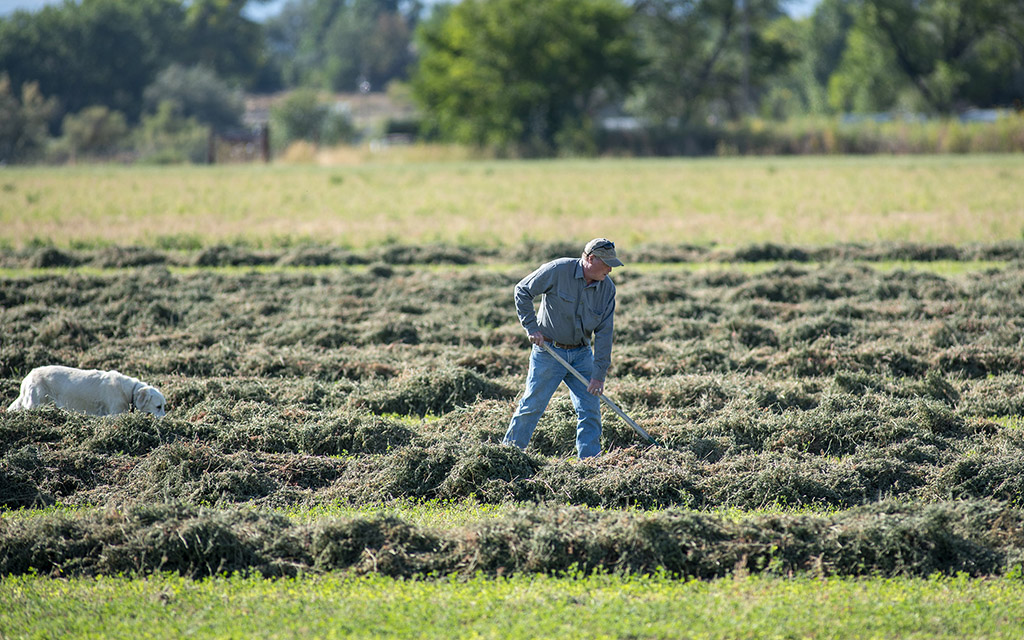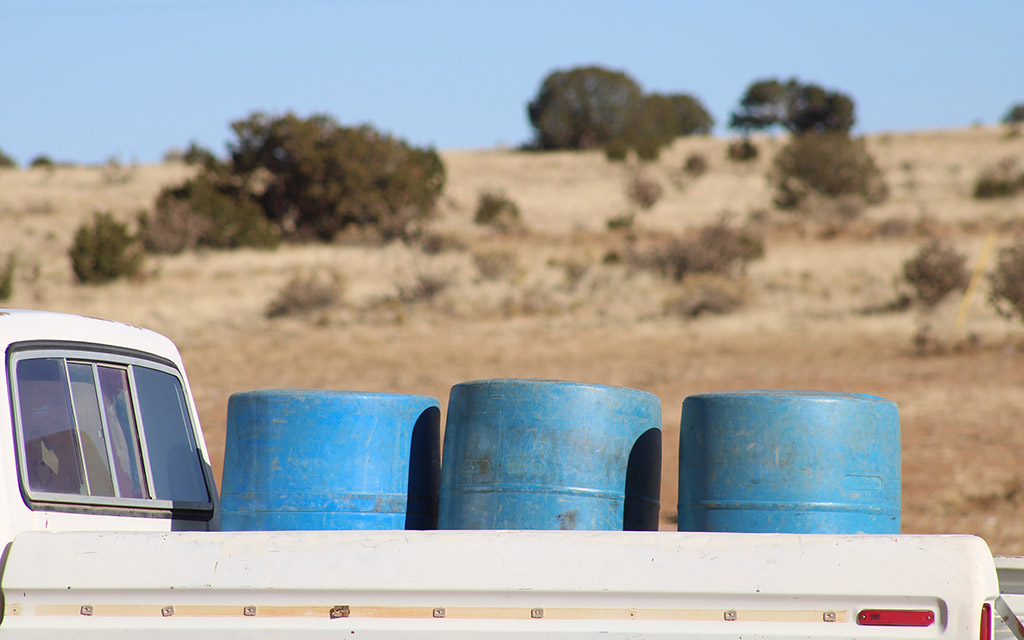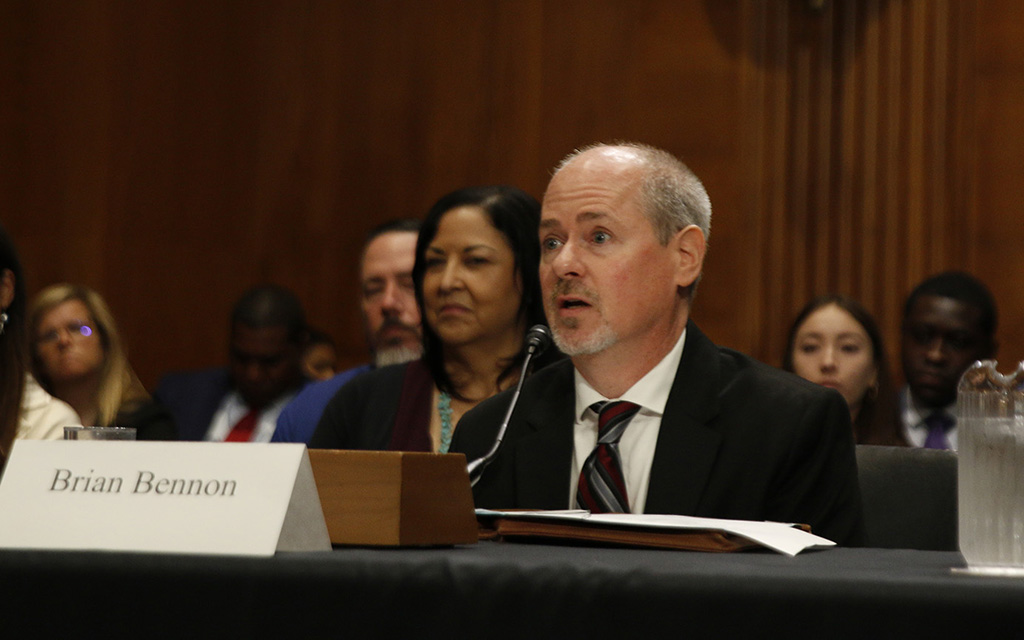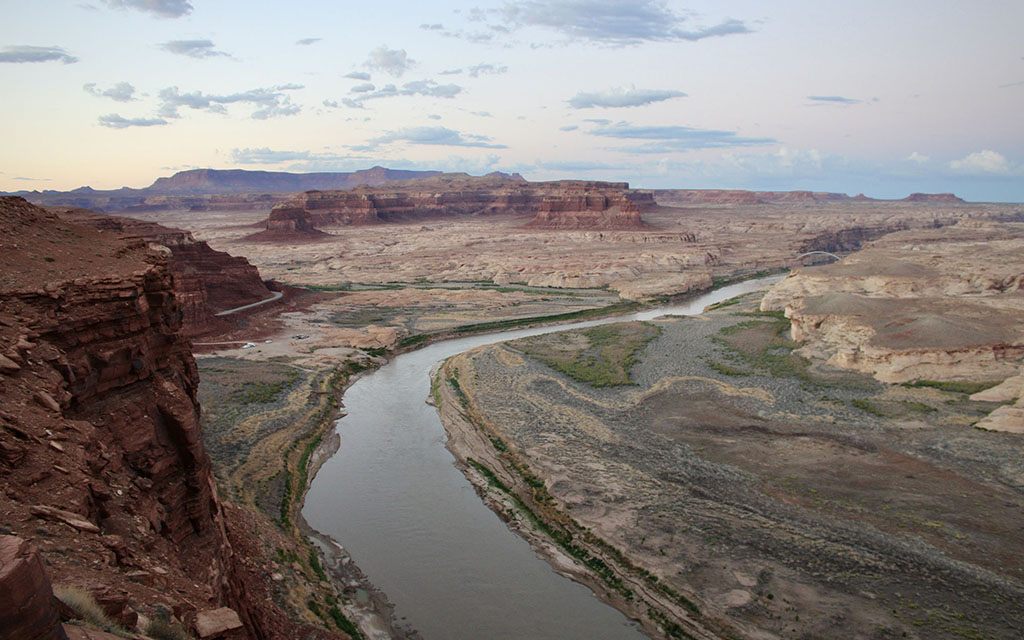
People unload a boat on the shores of Lake Powell on April 10, 2023. The nation’s largest reservoirs saw a boost from winter snow, but one Colorado River analyst says they are being depleted in a way that could quickly erase any temporary gains. (Photo by Alex Hager/KUNC)

A farmer works an alfalfa field in Colorado’s Grand Valley in this 2018. file photo. The state’s water leaders say they are trying to share the stories of growers who suffer during dry years. (Photo by Ted Wood/The Water Desk)
The annual Colorado River Water Users Association meets this week, but for the first time in several years, state water policy leaders say there’s less urgency for short-term fixes and more time to focus on long-term solutions.
A wet winter and a recent conservation deal have bought some breathing room as the biggest water policymakers in the arid West convene in Las Vegas at the Colorado River’s marquee annual event.
The event brings together hundreds of scientists, politicians, tribal members, farmers and others with a stake in the future of the water supply for roughly 40 million people across the Southwest. While they still face the daunting challenge of agreeing on water cutbacks by farms, ranches and cities from Wyoming to Mexico, many say last year’s wet winter helped clear the way for more productive talks.
“I think where we are heading into this one is, fortunately, not much to really get too excited about, which is a nice thing,” said JB Hamby, California’s top water negotiator.
Hamby, who hails from a farm district that uses more Colorado River water than any other single entity in the region, said water managers are at a “Goldilocks” level of urgency. Where past conferences, including 2022, focused on short-term conservation measures to protect the basin’s big reservoirs from infrastructural damage, now they can focus on devising a new set of river-sharing rules to replace the current set, which expires in 2026.
“Now we have an open runway to figure out post-2026 with a much lower temperature and clearer heads,” he said.
Hamby and other negotiators are tight-lipped about the progress of that negotiation process, but tend to project optimism about finding a collective solution. Hamby, who said he was shut out of negotiations as recently as January, now says the dynamics of river management talks have “shifted dramatically” for the better.
Hearts and minds
Formal talks about the nitty-gritty of post-2026 river guidelines mostly happen behind closed doors. But the seven states that use water from the Colorado River may see the conference as a place to garner sympathy and support from water experts around the basin.
“It seems like my constant challenge is making sure that we’re understood in the Upper Basin,” said Becky Mitchell, Colorado’s top water negotiator.
Colorado and its allies in the Upper Basin of the river— Utah, Wyoming and New Mexico – often say they feel the sting of dry years more sharply than other states. Because most of the river begins as snow in the Upper Basin, leaders in those states say their farmers and ranchers have to use less water after low-snow winters, while Lower Basin states – Arizona, California and Nevada – do not have to adjust because because they can count on a predictable delivery of water from Lake Powell every year.
“My next week is going to be spent figuring out how I tell these stories so that they resonate beyond Colorado,” Mitchell said, citing the story of one user who has had to use less than their full water allocation in 17 of the past 23 years.

Attendees mingle in the hallway at the Colorado River Water Users Association conference on Dec. 15, 2022. Farmers, journalists, academics, city officials and others gather in Las Vegas to hear policymakers chart the future of the Colorado River. (Photo by Alex Hager/KUNC)
While those dry-year impacts may be felt on a local scale, a 2022 study showed that the Upper Basin’s overall water use is not as responsive to the ebb and flow of winter as its leaders may make it out to be.
Lower Basin states have been making their own push to gin up good press, too. In October, a new federal report about the state of the Colorado River outlined the benefits of a wet winter and a three-state conservation deal in creating more space for talks about the long-term future of the water supply.
Around the time of the report’s release, water leaders in the Lower Basin mostly highlighted their conservation deal — both in press releases and statements to the media.
Some experts said their conservation work was not as significant as the boost from Mother Nature. And Politico recently reported that the conservation agreement may have unintended negative consequences: It could pay out up to $1.2 billion in exchange for water cutbacks, which Politico said is “likely to make a broader, long-term deal to save the West’s most important river more expensive.”
More room for tribes
Since the earliest days of Colorado River management, Indigenous people have been on the fringes of talks about how to share its water. Some of the 30 federally recognized tribes that use Colorado River water say they’re still being kept out of rooms where important water policy decisions are made.
Calls for greater inclusion of tribes have been a staple of recent annual meetings, but tribal water advocates say there’s still a need for more.
“We want our participation to be institutionalized,” said Lorelei Cloud, acting chairman of the Southern Ute Indian Tribe. “That is going to be key.”
Cloud said she and other Indigenous water leaders are pushing for legally protected seats at the table in post-2026 water management, seats designed to allow for changes in tribal, state or federal administrations.
Tribal leaders say some progress has been made toward a larger role in water talks. Cloud, who recently became the first Native American to serve on the Colorado Water Conservation Board, praised the efforts of her state and the Upper Colorado River Commission, which helps Colorado, Utah, Wyoming and New Mexico have a unified voice in water talks.
“We’ve had to hash out a lot of historical traumas and things that have happened to us, preventing us from being a part of those conversations,” she said. “In the Upper Basin, I think we’re blazing that trail right now. We’re ahead of the game.”
The discussion of tribal inclusion has often ignored the diverse needs of different tribes across the region, Indigenous leaders say.
“To think that there’s an ‘Indian solution’ really dishonors the uniqueness of the tribes,” Daryl Vigil, a member of the Jicarilla Apache Nation, said at a water law conference earlier this year.
That uniqueness, Cloud said, needs to be acknowledged in the water-sharing rules drawn up by 2026.
“We’re all going to do what is best for our tribe, because we’re a sovereign nation,” she said. “That’s where a lot of people don’t have the understanding that each tribe is going to work differently.”
Despite holding rights to about a quarter of the river’s flow, many tribes lack the funding and infrastructure to use their full allocations. Some also grapple with water quality issues: On the Navajo Nation, for example, almost 40% of homes don’t have access to clean water, and 15% of homes on the Southern Ute reservation don’t have running water at all.
Cloud said she plans to share the stories of those people at this week’s conference to “help other people to understand what our people go through to get water in their home, or to have water on a daily basis, That’s my duty as a tribal leader, to make those personal connections.”
‘Still really close to the edge of the cliff’
In spring, when Rocky Mountain snow started melting into the streams that feed the Colorado River, the message from water leaders was “don’t squander it.”
“The hydrology this year has been nothing short of amazing and I think it’s up to us to ensure that we don’t squander it,” Estevan López, the Colorado River negotiator for New Mexico, told the Nevada Independent in April.
Officials from Colorado and Arizona made similar statements. But so far, water use across the basin has not been significantly reduced.

Barrels, used to carry water to homes in To’Hajiilee, NM, sit in the back of a pickup truck on Nov. 15, 2021. Tribal communities around the Southwest often lack access to clean running water. (Photo by Alex Hager/KUNC)
“As we listen to the agreements, you would think that our rate of consumption was significantly less than it had ever been after any other wet year, and that is not the case,” said Jack Schmidt, who directs the Center for Colorado River Studies at Utah State University. “We are sort of using water at a similar rate as in other years.”
Schmidt, writing last month about the current status of Colorado River reservoir storage, showed that the boost from last winter has been relatively modest and is being depleted in a way that could quickly erase any temporary gains. He said the region is currently using water at an “unexceptional” rate, comparing it to 2011, 2017 and 2019, when big winter gains were consumed or lost to evaporation within two years.
“2023 just got us to take one step back from the edge of the cliff, but we’re still really close to the edge of the cliff,” Schmidt said.
He called for a change in how water data is reported to the public. He said the Bureau of Reclamation, the federal agency that manages the West’s major reservoirs, should more “transparently” publish data about the total amount of water stored in those reservoirs, rather than potential savings created by legal agreements.
“There are a lot of behind-the-scenes shell games that you can play with where you store water,” Schmidt said.
Common ground
A long-term fix to the Colorado River crisis often seems far off. Any new will need to bridge a number of gaps that have simmered for generations – long-standing feuds between states, tensions between big-money farm districts and fast-growing cities, and steady calls for greater inclusion of tribes.
But Western water leaders see one glimmer of hope: The majority of them agree on the nature and severity of the problem. Two decades of dry conditions, fueled by climate change, are shrinking the amount of water in the river and its reservoirs, and demand needs to be brought down substantially to create a sustainable long-term future for the river.
“The one optimism that I have is there is wide recognition amongst every single entity that takes Colorado River (water) in the basin, at least in the Lower Basin, we know that this is a new reality,” said Vineetha Kartha, Colorado River programs manager at the Central Arizona Project.
Kartha’s agency manages a 336-mile pipeline that brings Colorado River water across the Arizona desert to supply the Phoenix area. It is among the first water agencies in the basin to see cuts to its water supply under a federal mandate.
Kartha said that a solution may require new, innovative ideas like changes to the way water is measured or mandatory cutbacks are triggered. Regardless of how that solution is carried out, she said it must involve collaboration.
“I always tell my kids many hands make light work,” Kartha said. “That’s the same thing here.”
-This story is part of ongoing coverage of the Colorado River, produced by KUNC and supported by the Walton Family Foundation.

